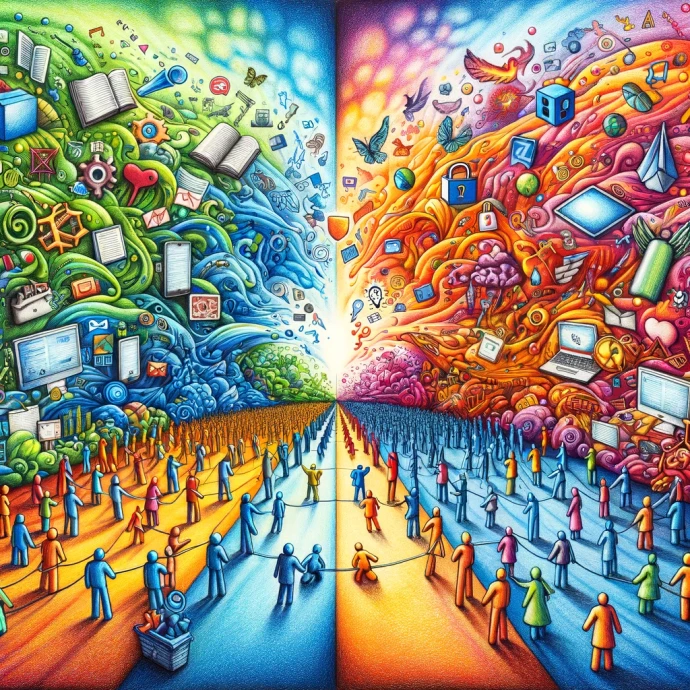Navigating the Dilemma: Open vs. Closed AI Models

In the short-evolving landscape of artificial intelligence (AI), a crucial debate is unfolding that can form the destiny of technology and society. At the heart of this debate is a question of openness: Should the development of powerful generative AI structures be an open book for all to make contributions to and analyze from, or should they be intently guarded secrets and techniques held via some? This discussion isn't just academic—it has profound implications for the productiveness of our economies, the stableness of our societies, and the energy dynamics of the various world's leading organizations.
The Promise of Open AI: Innovation and Accessibility
Proponents of open-supply AI models, consisting of Meta's LLaMA 2 or Hugging Face's Bloom, argue that those frameworks democratize entry to modern-day generation. By permitting users to customise and enhance upon present software program, open fashions are touted as catalysts for innovation and reliability. The rationale is straightforward: with extra minds scrutinizing and improving the code, the software no longer only receives better but additionally becomes more resilient towards screw-ups. Furthermore, open fashions introduce a stage of opposition that challenges the dominance of tech behemoths like Google, Microsoft, and OpenAI, who've poured billions into developing proprietary structures. This opposition is visible as critical for stopping monopolistic control over the future route of AI technology.
The Perils of Pandora's Box: The Risks of Open AI

However, the openness of AI also invitations risks. Critics, together with pioneers like Geoffrey Hinton, caution against the risks of creating effective AI gear too handy. The worry is that malevolent actors ought to take advantage of these open fashions for nefarious purposes, from spreading disinformation to creating cyber or biological weapons. This «Pandora's container» situation underscores a grim opportunity: by reducing the limitations to access, we'd inadvertently empower those with dangerous intentions.
OpenAI's Pivot: A Case Study in Caution
The adventure of OpenAI, the organization behind the modern ChatGPT, exemplifies the complexities of this debate. Initially committed to openness, OpenAI shifted in the direction of a more closed model, citing aggressive and protection issues. This pivot reflects a growing realization inside the AI network that the capability for misuse of generative AI models ought to outweigh the blessings of open-source improvement. OpenAI's serves as a cautionary story, suggesting that the stakes of AI development are too high for an unrestricted method.
The Ideological Battle: Control vs. Freedom in AI Development

Beneath the surface of this debate lies a deeper ideological conflict over the control of facts and generation. Critics of closed AI models accuse most important tech corporations of attempting to monopolize AI development beneath the guise of protection worries. They argue that those organizations' purpose is to control regulatory frameworks to stifle competition and cement their marketplace dominance. Conversely, advocates for open AI, like Yann LeCun of Meta, draw parallels with historical efforts to gate keep information, suggesting that the destiny of AI must be as unrestricted as the early net.
Finding a Middle Ground: The Path Forward
As the controversy rages on, it is clear that a binary technique to AI development—open as opposed to closed—is overly simplistic. The destiny probably lies in a nuanced compromise that balances the advantages of openness with the need for protection and obligation. Drawing parallels with the law of the automobile industry, a few specialists recommend a framework in which generative AI models are issued to safety requirements, even as customers are held responsible for their moves. This method acknowledges the capacity of open AI to foster innovation while recognizing the vital of mitigating the dangers associated with its misuse.
Conclusion: Embracing Complexity within the AI Era
As we stand at the crossroads of AI development, the choices we make these days will echo thru the corridors of destiny. It's a moment that demands considerate attention, a willingness to embody complexity, and an unwavering commitment to guide the evolution of AI in a path that advantages all of humanity. The path ahead isn't approximately deciding on among open and closed models in absolute phrases but approximately finding the proper balance that fosters innovation, guarantees protection, and promotes equitable entry to the transformative power of AI.

Become a part of digital history






Comments about Navigating the Dilemma: Open vs. Closed AI Models